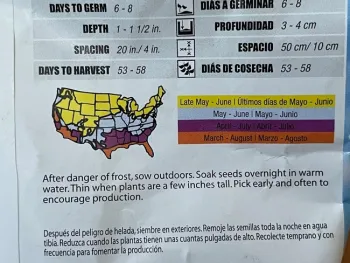New Normal?
There's a map on the back of your seed packet. Colored zones of the contiguous forty-eight states are highlighted. On the side the colors are identified as when to plant your seeds. Climate change has disrupted that map. Areas that were cooler in the spring are now getting warmer. Now I can plant earlier in the year and perhaps plant other types of crops more suitable for warmer areas. That's a good thing, right?

Climate change is changing our weather patterns. Droughts are longer and more severe. You can't grow plants without water. You must use water wisely. Whether it's using drip irrigation or reusing gray water or storing rainwater for future use, you must think how to be judicious in your water usage. Another water saving tip, use mulch around your plants.
Climate Change create conditions for wildfires. Depending on where you live fires can present an immediate danger. Smoke filled air can reduce the amount of sunlight your plants get. Smoky days cut down on your time to tend to your garden. Also, ash from the fires can affect the taste of your vegetables. Vintners in California have recently experienced this phenomenon.
Pollinators have their own biological clocks, and they may be early or late to pollenate your plants. Higher temperatures also invite insects to migrate to new areas. Before we had little concern for West Nile Virus but now it's here in California on a regular summer basis. Warm weather and damp areas breed mosquitoes the vector for West Nile Virus.
If you live by the coast or an estuary your climate change challenge is sea rise. You will see up to a foot of sea rise by 2030. This can flood your land or infiltrate your water table making it more saline.
So, what is the new normal and how do we deal with it?
The reduction of greenhouse gases emissions is key to fighting climate change. By growing your own food, you can reduce transportation emissions. Planting trees for food and shade helps reduce greenhouse emissions. Trees become carbon sinks (they store carbon) and they can also provide shade reducing air conditioning usage. Another added benefit is fruit trees provide food. Trees also help retain water in the soil.
Reduce water usage, get rid of that lawn. There are many drought-tolerant plants such as Ceanothus and succulents to decorate your yard.
Do not use gas powered lawn mowers, leaf blowers, hedge clippers and the like. Emissions from those machines contribute to climate change. There are a number of electric alternatives available, and you can also do it manually. Ouch! Arthritis, I'll get an electric trimmer.
Conserve energy wherever and whenever you can. If you have a gas-powered car, make less trips to the stores by planning what you need in advance.
If we don't change what we are doing, we will be constantly changing what is NORMAL. All the research on time to plant, what to plant, when to water, will become useless.
